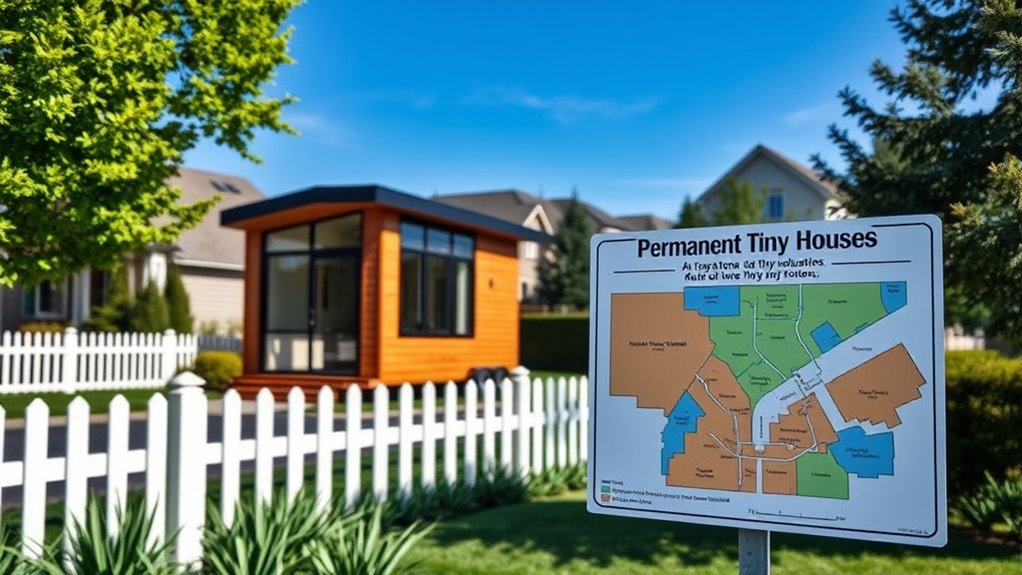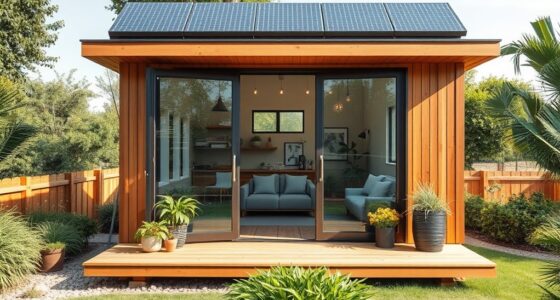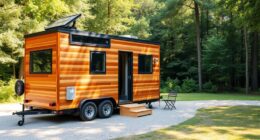To understand zoning rules for your permanent tiny house, you need to check local regulations about setbacks, building codes, and property use restrictions. These rules determine where you can place your tiny home, what permits you’ll need, and if exceptions or variances are possible. Keeping compliant avoids fines and legal issues. If you want to learn about specific zoning requirements and how to navigate them, keep exploring the details that follow.
Key Takeaways
- Zoning regulations determine where tiny houses can be permanently placed, often requiring compliance with specific district rules.
- Building codes specify safety standards for electrical, plumbing, and structural components of tiny homes.
- Property setback rules limit how close tiny houses can be built to property lines, streets, and neighboring properties.
- Variances may be available to allow exceptions or adjustments to standard zoning and setback requirements.
- Early consultation with local zoning and building authorities helps ensure compliance and smooth approval processes.

If you’re considering building a tiny house, understanding zoning rules is vital to guarantee your project complies with local regulations. Zoning laws can considerably influence where you can place your tiny home, what permits you’ll need, and how your property can be used. One of the most critical aspects to consider is how building codes and property setbacks affect your plans. Building codes set the standards for safety, durability, and habitability of your tiny house, guaranteeing it meets minimum requirements for things like electrical wiring, plumbing, insulation, and structural integrity. Ignoring these codes can result in costly fines or even having to tear down your tiny home, so it’s necessary to familiarize yourself with the specific building regulations in your area. Local building departments often require inspections and permits before you start construction, so you’ll want to gather all necessary documentation early on. Self Watering Plant Pots are an example of a product that requires understanding local regulations if you plan to incorporate them into your tiny house setup or landscape design. Property setbacks are another key factor influencing where your tiny house can be situated on your property. Property setbacks are restrictions on how close a structure can be built to property lines, roads, or neighboring properties. These setbacks are designed to ensure safety, privacy, and proper drainage, but they can also limit the size and placement of your tiny house. For example, if the setback from the street is 20 feet, you can’t place your tiny home any closer than that to the road, which could impact your design options. Similarly, side and rear yard setbacks prevent you from building too close to neighboring properties, affecting your available space. It’s vital to check the specific setback requirements in your zoning district because they vary widely from one jurisdiction to another. Sometimes, local zoning codes may allow for exceptions or variances, especially for tiny homes, but you’ll need to apply for these in advance and demonstrate your project meets certain criteria. Understanding the interplay between building codes and property setbacks helps you plan a tiny house that not only meets legal standards but also fits comfortably on your property. It’s wise to consult with local zoning offices or a professional familiar with your area’s regulations early in your planning process. This way, you can avoid surprises and guarantee your tiny home is compliant from the start. Ultimately, paying close attention to these rules will save you time, money, and stress, making your tiny house dream a reality within the bounds of local law.
Frequently Asked Questions
Can Tiny Houses Be Legally Used as Permanent Residences?
Yes, you can use a tiny house as a permanent residence, but you need to make sure tiny house legality and zoning compliance. Check local zoning laws to confirm if tiny houses are permitted on your property and if they meet building codes. Some areas require your tiny house to be on a foundation or meet specific size standards. Staying informed and compliant helps you enjoy your tiny house as a legal, permanent home.
Are There Specific Zoning Districts That Permit Tiny Houses?
Think of zoning district classifications as neighborhoods with their own rules. Yes, some districts do permit tiny houses, but it varies widely. You need to check local regulations on permanent residence regulations, as they often specify where tiny houses can stand. In certain zones, tiny houses are allowed as primary residences, while others restrict them to guest or accessory structures. Always verify with your city or county to find the right zone for your tiny home dreams.
How Do Zoning Rules Vary Between Urban and Rural Areas?
In urban areas, zoning rules tend to be stricter, with limited zoning flexibility and tighter density regulations that can restrict tiny houses. Conversely, rural areas usually offer more zoning flexibility and relaxed density rules, making it easier for you to build a tiny house. You’ll find that rural zones often support higher density and fewer restrictions, giving you more freedom to design and place your tiny home without as many legal hurdles.
What Are the Impact Fees or Taxes for Tiny House Developments?
You might think tiny houses are free, but impact fees and property taxes say otherwise. You could qualify for impact fee exceptions, saving you a bundle, yet you’ll still face property tax implications based on your home’s value. While some areas waive certain fees, others hit you with hefty rates. Be prepared for ongoing costs that can turn your cozy dream into a surprisingly expensive endeavor.
Are There Size or Setback Restrictions for Tiny Houses on Wheels?
You need to check building codes and neighborhood covenants because they often set size and setback restrictions for tiny houses on wheels. Many areas require a minimum distance from property lines and limit the overall size to ensure safety and harmony with neighboring properties. Failing to follow these rules can lead to fines or removal orders, so always verify local regulations before parking or building your tiny home on wheels.
Conclusion
Finding your way through zoning rules for tiny houses might seem daunting, but with a little research, you’ll find the perfect spot to settle down. Remember, understanding local regulations is key—it’s worth the effort to avoid future headaches. Keep in mind, the devil is in the details, so double-check every rule and restriction. Once you do, you’ll be able to turn your tiny house dream into a reality without any surprises along the way.





